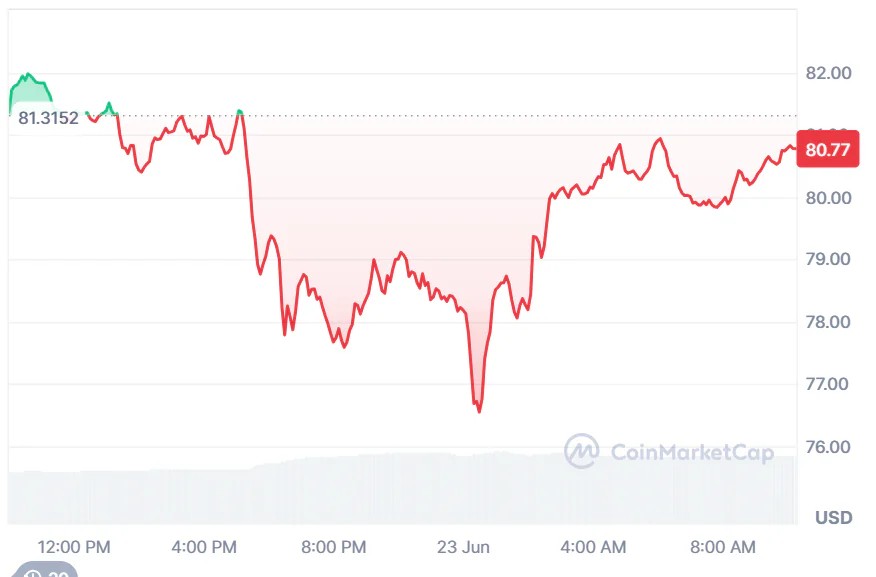Litecoin Price Prediction 2026: Market Recovery in Sight as Qubetics Eyes Exchange Listing

As the cryptocurrency market stabilizes following global political turbulence and the tail end of a prolonged bear cycle, several digital assets are regaining traction. Among them, Litecoin and Qubetics present two contrasting yet compelling narratives for those analyzing the 2026 landscape. While Litecoin retains its role as a dependable digital cash protocol, Qubetics emerges as a disruptive force focused on cross-chain infrastructure and real-world asset tokenization. Both are positioned differently, but both carry the hallmarks of long-term relevance.
Litecoin has drawn attention with its solid post-halving rebound, improved privacy mechanisms, and renewed technical momentum. Its resilience has solidified its status as a “store-of-value meets payment network,” and analysts now forecast renewed interest as macroeconomic recovery pairs with altcoin resurgence. Meanwhile, Qubetics is shifting the focus entirely. It has moved beyond conventional use cases by introducing a Web3-powered marketplace capable of tokenizing real-world assets across global jurisdictions — solving one of blockchain’s biggest bottlenecks: interoperability at scale.
These dual trajectories present a rich opportunity for observers: one rooted in legacy with proven uptime, and another preparing for exponential scale through protocol innovation. With Litecoin targeting $150 and Qubetics heading toward a $0.40 listing on a Tier 1 exchange, both are poised to make headlines in vastly different ways.
Litecoin’s Legacy and Post-Halving Strength
Litecoin was designed to offer fast, low-cost digital payments — and it has delivered for over a decade. Operating four times faster than Bitcoin and maintaining far cheaper transaction fees, Litecoin has served as a testing ground for critical blockchain advancements such as Segregated Witness (SegWit) and atomic swaps. Its 84 million coin cap mirrors Bitcoin’s deflationary appeal while offering broader transactional utility for day-to-day financial use cases.
Most notably, the MimbleWimble Extension Blocks (MWEB) upgrade has given Litecoin a new edge by integrating privacy features and improved scalability. The optional confidentiality of transactions, paired with its lightweight architecture, ensures it remains appealing to those seeking anonymity without sacrificing speed. Institutional players and developers alike have continued to take note of this balance, particularly as regulation pushes for more transparent yet flexible solutions.
With a current market cap exceeding $6.4 billion and sustained daily trading volume, Litecoin has defied volatility. Analysts note that the asset has maintained a base above $84 after recovering from previous lows, suggesting robust demand. Its infrastructure remains battle-tested, and its seamless integration with merchant payment gateways keeps it a strong candidate in payment-based portfolios.
Why Litecoin’s Privacy Upgrade Could Drive 2026 Price Recovery
The integration of MWEB not only enhanced Litecoin’s privacy capabilities but also unlocked new pathways for broader adoption. As decentralized finance and confidential transactions gain more attention globally, Litecoin now offers optional anonymity — a rare feature among leading Layer 1s. This aligns with emerging regulatory models that may allow for privacy tools under compliant frameworks, increasing Litecoin’s viability across both retail and enterprise use cases.
From a protocol-level perspective, Litecoin’s simplicity continues to stand in stark contrast to more complex Layer 1 ecosystems. The result? Lightweight, stable architecture with fewer surface-level vulnerabilities — and a clear value proposition for those focused on speed, cost-efficiency, and practical application. As a result, interest is expected to grow not just among traditional crypto users but also among financial platforms exploring hybrid private-public architecture.
Importantly, Litecoin’s current ecosystem updates place it in a unique middle ground: it’s no longer just a “silver to Bitcoin’s gold,” but a forward-compatible blockchain with lightweight privacy, legacy trust, and sustainable transaction throughput. These components make it a strategic pick in an increasingly niche-driven market.
Litecoin Price Prediction 2026: Will It Hit $150?
Multiple forecasts suggest Litecoin could climb to a price range of $150 to $178 by the end of 2026. Changelly’s models expect an average of $158.79 with monthly growth beginning around $114.92 in January. Bullish estimates hinge on rising institutional exposure, the success of MWEB, and a rebound in altcoin sentiment. CoinCodex and AInvest projections fall within a broader window, noting a possible $98.14 to $190 trading range depending on macroeconomic factors.
Much of Litecoin’s 2026 success will depend on Bitcoin’s market leadership, which historically drives correlated movement across legacy altcoins. If Bitcoin hits new all-time highs, Litecoin is likely to ride that momentum upward — albeit at a steadier pace. With many community participants focusing on mid-cap diversification amid ETF growth, Litecoin remains a strategic asset within this narrative.
Still, some models are more reserved. Community sentiment aggregated by Binance pegs 2026 pricing closer to $90, reflecting cautious optimism rather than euphoric speculation. This divergence highlights Litecoin’s dual nature: it’s a safe-haven for the pragmatic, not the speculative.
Qubetics Builds Real-World Asset Infrastructure for 2026 and Beyond
While Litecoin remains a reliable foundation, Qubetics is laying the groundwork for blockchain’s next major evolution — cross-chain tokenization of real-world assets. With its Real World Asset Tokenisation Marketplace, Qubetics facilitates seamless integration between traditional finance and blockchain networks by converting physical or legal assets into compliant digital forms.
For example, imagine a logistics company in Germany digitizing container ownership certificates using Qubetics, enabling frictionless real-time updates across Ethereum and BNB Chain. Or consider an art investment platform in Canada tokenizing fine art portfolios so they can be securely traded and fractionalized by verified wallets in Dubai and Singapore. These aren’t hypothetical dreams — they are scenarios Qubetics is actively building for.
The system relies on its multi-protocol foundation, enabling smart contracts and data to interact across blockchains without security compromise. This architecture unlocks serious institutional appeal. As global regulation slowly opens the door to tokenized bonds, equities, and IP rights, Qubetics is positioning itself to be the go-to infrastructure provider.
Qubetics Presale Metrics Show Serious Growth Potential
The Qubetics crypto presale is nearing its final phase, and the numbers speak volumes. Currently in Stage 37, the presale price stands at $0.3370, with over $18.1 million raised and more than 516 million tokens already sold. The platform now has 28,300+ holders, and only less than 10 million tokens remain at this tier before the public listing kicks in at $0.40.
That 20% upside is just the beginning. With the total token supply reduced from 4 billion to 1.36 billion, and 38.55% of tokens allocated to public holders, Qubetics is among the most decentralized presale tokens available. At the current rate, a $5,500 stake yields roughly 16,319 $TICS tokens. If the token reaches $1, that’s a valuation of $16,319, delivering a near 197% return. At $5, the value grows to $81,595, and at $10, that jumps to $163,190.
The figures are backed by tokenomics, utility, and market timing — factors analysts consider when identifying high-upside, high-utility plays. And with the Qubetics presale nearly sold out, the opportunity window is narrowing fast.
Listing Soon at $0.40: What to Expect from Qubetics
The next inflection point for Qubetics is its confirmed listing on one of the world’s top 10 centralized exchanges, with a set listing price of $0.40. Though the exact date remains unannounced, the listing is imminent, and analysts expect a minimum 20% jump in price as the token becomes available to the public for the first time.
This listing is more than a liquidity event — it’s a credibility marker. It elevates Qubetics from a promising presale into the wider market spotlight. Once listed, trading pairs, user onboarding, and institutional monitoring will dramatically increase visibility and volume.
Community members who joined early are likely to be rewarded for their positioning. With the token supply limited and staking opportunities expected to roll out post-launch, Qubetics is not only targeting price movement but platform-wide adoption. It’s the kind of launch that historically sets the tone for the next wave of blockchain growth.
Conclusion: Different Paths, Same Market Cycle
In comparing Litecoin and Qubetics, the choice isn’t binary — it’s strategic. Litecoin, with its privacy-focused upgrades and reliable framework, represents the digital cash thesis in a compliant age. It’s mature, efficient, and backed by years of trust. Qubetics, in contrast, delivers innovation. Its Real World Asset Tokenisation Marketplace, soon-to-launch CEX listing, and scarce supply offer a unique angle on blockchain’s future.
The keyword for 2026 is alignment. If global financial systems begin integrating tokenized real-world assets, Qubetics may become essential. If digital payment adoption grows under regulation, Litecoin will continue to thrive. In this way, both stand as representative of the evolving layers of the crypto economy.
For those seeking the best crypto presale, Qubetics remains unmatched in its blend of infrastructure, tokenomics, and imminent exchange exposure. Meanwhile, those drawn to the legacy and simplicity of blockchain finance will find strength in Litecoin’s 2026 trajectory.
For More Information:
Qubetics: https://qubetics.com
Presale: https://buy.qubetics.com/
Telegram: https://t.me/qubetics
Twitter: https://x.com/qubetics

Source: Litecoin Price Prediction 2026: Market Recovery in Sight as Qubetics Eyes Exchange Listing








